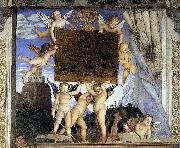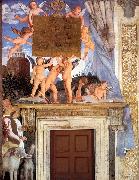
|
Andrea Mantegna
|
|||
|
|
|||
| Italian 1431-1506 Andrea Mantegna Locations Mantegna was born in Isola di Carturo, close to Padua in the Republic of Venice, second son of a carpenter, Biagio. At the age of eleven he became the apprentice of Francesco Squarcione, Paduan painter. Squarcione, whose original vocation was tailoring, appears to have had a remarkable enthusiasm for ancient art, and a faculty for acting. Like his famous compatriot Petrarca, Squarcione was something of a fanatic for ancient Rome: he travelled in Italy, and perhaps Greece, amassing antique statues, reliefs, vases, etc., forming a collection of such works, then making drawings from them himself, and throwing open his stores for others to study. All the while, he continued undertaking works on commission for which his pupils no less than himself were made available. San Zeno Altarpiece, (left panel), 1457-60; San Zeno, VeronaAs many as 137 painters and pictorial students passed through Squarcine's school, which had been established towards 1440 and which became famous all over Italy. Padua was attractive for artists coming not only from Veneto but also from Tuscany, such as Paolo Uccello, Filippo Lippi and Donatello. Mantegna's early career was shaped indeed by impressions of Florentine works. At the time, Mantegna was said to be a favorite pupil; Squarcione taught him the Latin language, and instructed him to study fragments of Roman sculpture. The master also preferred forced perspective, the lingering results of which may account for some Mantegna's later innovations. However, at the age of seventeen, Mantegna separated himself from Squarcione. He later claimed that Squarcione had profited from his work without paying the rights. His first work, now lost, was an altarpiece for the church of Santa Sofia in 1448. The same year Mantegna was called, together with Nicol?? Pizolo, to work with a large group of painters entrusted with the decoration of the Ovetari Chapel in the apse of the church of Eremitani. It is probable, however, that before this time some of the pupils of Squarcione, including Mantegna, had already begun the series of frescoes in the chapel of S. Cristoforo, in the church of Sant'Agostino degli Eremitani, today considered his masterpiece. After a series of coincidences, Mantegna finished most of the work alone, though Ansuino, who collaborated with Mantegna in the Ovetari Chapel, brought his style in the Forl?? school of painting. The now censorious Squarcione carped about the earlier works of this series, illustrating the life of St James; he said the figures were like men of stone, and had better have been colored stone-color at once. This series was almost entirely lost in the 1944 Allied bombings of Padua. The most dramatic work of the fresco cycle was the work set in the worm's-eye view perspective, St. James Led to His Execution. (For an example of Mantegna's use of a lowered view point, see the image at right of Saints Peter and Paul; though much less dramatic in its perspective that the St. James picture, the San Zeno altarpiece was done shortly after the St. James cycle was finished, and uses many of the same techniques, including the classicizing architectural structure.) San Luca Altarpiece, 1453; Tempera on panel; Pinacoteca di Brera, MilanThe sketch of the St. Stephen fresco survived and is the earliest known preliminary sketch which still exists to compare to the corresponding fresco. Despite the authentic look of the monument, it is not a copy of any known Roman structure. Mantegna also adopted the wet drapery patterns of the Romans, who derived the form from the Greek invention, for the clothing of his figures, although the tense figures and interactions are derived from Donatello. The drawing shows proof that nude figures were used in the conception of works during the Early Renaissance. In the preliminary sketch, the perspective is less developed and closer to a more average viewpoint however. Among the other early Mantegna frescoes are the two saints over the entrance porch of the church of Sant'Antonio in Padua, 1452, and an altarpiece of St. Luke and other saints (at left) for the church of S. Giustina, now in the Brera Gallery in Milan (1453). As the young artist progressed in his work, he came under the influence of Jacopo Bellini, father of the celebrated painters Giovanni and Gentile, and of a daughter Nicolosia. In 1453 Jacopo consented to a marriage between Nicolosia to Mantegna in marriage. | |||
|
|
|||
|
Inscription with Putti new25/Andrea Mantegna-377787.jpg Painting ID:: 87993 |
between 1465(1465) and 1474 cyf | ||
|
|
|||
|
Andrea Mantegna
|
|||
|
|
|||
| Italian 1431-1506 Andrea Mantegna Locations Mantegna was born in Isola di Carturo, close to Padua in the Republic of Venice, second son of a carpenter, Biagio. At the age of eleven he became the apprentice of Francesco Squarcione, Paduan painter. Squarcione, whose original vocation was tailoring, appears to have had a remarkable enthusiasm for ancient art, and a faculty for acting. Like his famous compatriot Petrarca, Squarcione was something of a fanatic for ancient Rome: he travelled in Italy, and perhaps Greece, amassing antique statues, reliefs, vases, etc., forming a collection of such works, then making drawings from them himself, and throwing open his stores for others to study. All the while, he continued undertaking works on commission for which his pupils no less than himself were made available. San Zeno Altarpiece, (left panel), 1457-60; San Zeno, VeronaAs many as 137 painters and pictorial students passed through Squarcine's school, which had been established towards 1440 and which became famous all over Italy. Padua was attractive for artists coming not only from Veneto but also from Tuscany, such as Paolo Uccello, Filippo Lippi and Donatello. Mantegna's early career was shaped indeed by impressions of Florentine works. At the time, Mantegna was said to be a favorite pupil; Squarcione taught him the Latin language, and instructed him to study fragments of Roman sculpture. The master also preferred forced perspective, the lingering results of which may account for some Mantegna's later innovations. However, at the age of seventeen, Mantegna separated himself from Squarcione. He later claimed that Squarcione had profited from his work without paying the rights. His first work, now lost, was an altarpiece for the church of Santa Sofia in 1448. The same year Mantegna was called, together with Nicol?? Pizolo, to work with a large group of painters entrusted with the decoration of the Ovetari Chapel in the apse of the church of Eremitani. It is probable, however, that before this time some of the pupils of Squarcione, including Mantegna, had already begun the series of frescoes in the chapel of S. Cristoforo, in the church of Sant'Agostino degli Eremitani, today considered his masterpiece. After a series of coincidences, Mantegna finished most of the work alone, though Ansuino, who collaborated with Mantegna in the Ovetari Chapel, brought his style in the Forl?? school of painting. The now censorious Squarcione carped about the earlier works of this series, illustrating the life of St James; he said the figures were like men of stone, and had better have been colored stone-color at once. This series was almost entirely lost in the 1944 Allied bombings of Padua. The most dramatic work of the fresco cycle was the work set in the worm's-eye view perspective, St. James Led to His Execution. (For an example of Mantegna's use of a lowered view point, see the image at right of Saints Peter and Paul; though much less dramatic in its perspective that the St. James picture, the San Zeno altarpiece was done shortly after the St. James cycle was finished, and uses many of the same techniques, including the classicizing architectural structure.) San Luca Altarpiece, 1453; Tempera on panel; Pinacoteca di Brera, MilanThe sketch of the St. Stephen fresco survived and is the earliest known preliminary sketch which still exists to compare to the corresponding fresco. Despite the authentic look of the monument, it is not a copy of any known Roman structure. Mantegna also adopted the wet drapery patterns of the Romans, who derived the form from the Greek invention, for the clothing of his figures, although the tense figures and interactions are derived from Donatello. The drawing shows proof that nude figures were used in the conception of works during the Early Renaissance. In the preliminary sketch, the perspective is less developed and closer to a more average viewpoint however. Among the other early Mantegna frescoes are the two saints over the entrance porch of the church of Sant'Antonio in Padua, 1452, and an altarpiece of St. Luke and other saints (at left) for the church of S. Giustina, now in the Brera Gallery in Milan (1453). As the young artist progressed in his work, he came under the influence of Jacopo Bellini, father of the celebrated painters Giovanni and Gentile, and of a daughter Nicolosia. In 1453 Jacopo consented to a marriage between Nicolosia to Mantegna in marriage. | |||
|
|
|||
|
Inscription with Putti new25/Andrea Mantegna-467953.jpg Painting ID:: 87994 |
between 1465(1465) and 1474 cyf | ||
|
|
|||
|
Also Buy::. For Following Paintings / Artists / Products, Please Use Our Search Online: |









